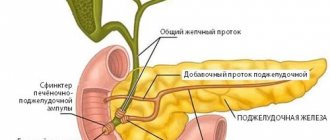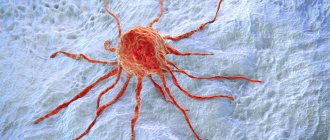Above each kidney are paired glandular organs - the adrenal glands, which produce hormones that support vascular health and protect against stress, controlling the distribution of proteins, fats, carbohydrates and water-salt balance.
Adrenal malignant tumors are detected extremely rarely in medical practice. Most often, this organ is affected by benign tumor processes.
Adrenal cancer is a malignant lesion of glandular tissue and occurs in approximately 3-5% of the total number of all oncologies. This type of cancer poses the greatest danger to the lung and liver structures, into which it most often metastasizes.
Children under 5 years of age and 40-50 year old adults are most prone to adrenal malignancy. Moreover, for every sick man there are about 3 women, that is, representatives of the fairer sex suffer from adrenal cancer three times more often than men.
The Yusupov Hospital has created all the conditions for the treatment of patients with adrenal cancer. At the oncology clinic, patients stay in comfortable rooms. Doctors diagnose diseases using modern equipment from leading world manufacturers. The main treatment for adrenal cancer is surgery. Oncologists use modern chemotherapy drugs to treat malignant tumors of the adrenal glands. Radiologists use innovative radiotherapy techniques to irradiate the tumor and the pathways of cancer cell metastasis.
How does oncology develop?
Cancer begins with the appearance in the body of just one altered cell, which is formed due to hereditary characteristics or various diseases, multiplies and creates a tumor. Most of these cells detect and destroy the immune system, but some of them manage to hide from the attention of our natural defenses or resist it. They enter the circulatory or lymphatic system. The lymphatic system complements the cardiovascular system. The lymph circulating in it - the intercellular fluid - washes all the cells of the body and delivers the necessary substances to them, taking away waste. Lymph nodes located throughout its network, acting as “filters,” identify and neutralize dangerous substances. systems., with their help they spread throughout the body, become established in other tissues and create metastases - additional foci of the disease.
What is the adrenal gland, why do we need it and how does oncology develop in it?
Each adrenal gland consists of two structures.
Outside the organ is the cortical layer
, in which most tumors arise. It produces important hormones:
- Cortisol
– helps the body cope with stress. - Aldosterone
– regulates blood pressure and the amount of salt in the blood. - Androgens
, which can be converted to other forms of hormones: - estrogens necessary for the proper functioning of the ovaries, uterus, vagina and mammary glands,
- as well as testosterone, which is involved in the production of sperm, affects the development of bone and muscle tissue in men.
In its inner part there is a medulla
, which is a continuation of the nervous system. It produces adrenaline, which helps us quickly respond to stress and extreme situations. When it is released, the pulse quickens, blood flow in the body is redistributed, minor vessels narrow, and important ones supplying the brain and heart expand. Dangerous neoplasms also arise in this area of the organ – neuroblastomas, which develop from nerve cells.
Doctors distinguish 2 types of adrenal cortex tumors:
- Adenomas
: benign, which means they do not grow into surrounding tissues and do not spread throughout the body. As a rule, their size does not exceed 5 centimeters in diameter, and most of their owners do not have any symptoms and are not aware of their disease. Some are discovered by chance during testing for other health problems. - Carcinomas
are cancers, which we will discuss in detail in this text.
Classification
All subcortical tumors are divided into two categories:
- Formations of the cortical layer;
- Brain tumors.
In addition, adrenal cancer can be primary or secondary. Primary tumors can be hormonally active or inactive. In addition, adrenal tumors are divided into:
- Corticosteromas - such formations disrupt the course of metabolic processes;
- Androsteromas – form the appearance of secondary sexual characteristics in women;
- Aldosteromas - disrupt the water-salt balance in the body;
- Corticoandrosteromas - such tumors combine androsteromas and corticosteromas;
- Pheochromocytomas – formed in the adrenal medulla;
- Neuroblastomas - formed mainly in children;
- Carcinomas are the most common type of adrenal cancer.
Adrenal cancer is staged as follows:
- Stage I is typical for a tumor no larger than 5 cm;
- Stage II – the tumor exceeds 5 cm, but there is no invasion;
- Stage III – tumors of different sizes that have local invasion, but do not grow into neighboring organs;
- Stage IV – tumors of different sizes that invade neighboring organs.
Causes of adrenal cancer
Scientists and doctors do not know exactly why this type of cancer develops in the body of a particular person - they only know the factors that increase the likelihood of this event.
Genetics
Most cases of adrenal cancer are not hereditary, but up to 15% of them are caused by mutations, or changes in genes that contain information about the body's characteristics. These include:
- Li-Fraumeni syndrome
is a rare disease that increases the risk of several types of cancer, including breast, brain, and bone. - Beckvidet-Wiedemann syndrome
, resulting in disproportionate growth of the body and internal organs such as the liver, spleen, kidneys and tongue. - Familial adenomatous polyposis
, which causes the formation of hundreds of polyps - tissue growths in the intestines. - Multiple endocrine neoplasia
, which significantly increases the likelihood of tumors of three glands: pituitary gland The pituitary gland is a small gland located at the base of the brain that affects metabolism, body growth and reproductive function in men and women., parathyroid The parathyroid gland regulates the amount of calcium in the body. and pancreasThe pancreas produces substances necessary for digesting food and regulates blood sugar levels. - Lynch syndrome
is an inherited disease that increases the chances of developing colon, stomach and other cancers, including the adrenal glands.
Lifestyle
Excess weight, smoking, insufficient exercise and exposure to chemicals can cause many types of cancer. To date, the effect of these factors on the adrenal glands has not been proven, but part of the scientific community believes that tobacco smoke has a similar effect.
Causes
In general, malignant adrenal tumors can have a hereditary or sporadic etiology.
The following factors can trigger the oncological process:
- Consumption of carcinogenic substances, which are found in large quantities in some drinks and foods;
- Unhealthy habits such as using tobacco or alcohol;
- Age characteristics. Cancers of this nature primarily affect young children and older patients;
- Family predisposition, the presence of a genetic predisposition to adrenal cancer processes;
- Multiple endocrine tumors;
- The presence of hereditary pathologies such as Li-Fraumeni syndrome, hyperplastic polyposis, Beckwith-Wiedemann, etc.
It is quite difficult to definitively determine the causes of adrenal cancer, so the etiology of the disease often remains unknown.
Signs and symptoms of adrenal cancer
As a rule, signs of the disease do not appear immediately - usually a person feels them only after the tumor grows to a fairly large size. In about half of patients, health problems arise due to hormones produced by cancer, and in another 50% they develop when it grows and compresses nearby organs.
In children, symptoms are most often caused by androgens. Androgens are involved in the production of sperm and also affect the development of bone and muscle tissue. – “male” hormones secreted by cancer. The most common of these are excessive hair growth on the face and body, for example in the pubic area and armpits. Under the influence of estrogens, which are necessary for the proper functioning of the ovaries, uterus, vagina and mammary glands, girls often begin early puberty, and boys have enlarged mammary glands.
In adults, the influence of these substances is less noticeable, since their body is already fully formed. It is for this reason that women with estrogen-producing cancer and men with androgen-producing tumors in the early stages do not show any signs of the disease.
Problems are easier to notice if the tumor produces a hormone that is normally present in the body in small quantities. In such cases, the representatives of the stronger sex have enlarged breasts, become painful, and problems appear in the intimate sphere - their sex drive decreases and erectile dysfunction occurs. In women, hair grows on the face and body, bald spots appear, the voice deepens, and menstrual cycles become irregular.
An increase in cortisol levels, which the body needs to cope with stress, leads to the development of a number of symptoms, such as:
- obesity;
- deposition of fatty tissue in the face, neck, chest, abdomen, as well as behind the neck and shoulders;
- rounding of the face;
- formation of striae - purple stretch marks on the abdomen;
- excessive hair growth on the face, chest and back in women;
- menstrual irregularities;
- weakness and loss of muscle mass in the legs;
- high blood pressure;
- the appearance of bruises and bruises even after minor exposure to the skin;
- depression, mood swings;
- osteoporosis - a decrease in calcium content and bone strength, and consequently their frequent fractures;
- high blood sugar levels, often leading to diabetes - the body's inability to transfer glucose from the blood to tissue cells to obtain the energy they need.
The main symptoms of producing too much aldosterone, which regulates the amount of salt in the blood, are high blood pressure, weakness, muscle cramps and low potassium levels.
As a tumor grows and increases in size, a person may experience pain in the areas closest to the tumor, a feeling of fullness in the abdomen, or problems with eating due to a constant feeling of fullness in the stomach.
Survival prognosis
The level of postoperative survival directly depends on the degree of spread of the oncological process.
When treating stage 1-2 adrenal cancer, positive treatment results are achieved in approximately 80% of cases. But at stage 4 cancer, the prognosis is negative, because extensive metastasis occurs.
In general, the 5-year survival rate of cancer patients with stage 1 of this type of cancer is about 80%, with stage 2 – 50%, with stage 3 – 20%, and with stage 4 – 10%.
Adrenal carcinoma has a very unfavorable survival prognosis; such cancer patients live less than one and a half years. Even with early detection and treatment of the tumor, the life expectancy of such patients is very low.
Doctors at the Yusupov Hospital claim that adrenal cancer can be cured forever if you start treatment at an early stage of the disease, and for this you need to undergo a thorough diagnosis.
Diagnosis of adrenal cancer
A detailed and high-quality examination is an extremely important point for any patient. It is the data obtained during this process that allows doctors to see how seriously the body has been damaged and to select the best treatment in each specific situation. In addition, time plays an important role, since the sooner doctors receive the necessary data, the sooner they can begin to fight the disease.
Oncology specialists conduct a full diagnosis of adrenal cancer using the most modern equipment - efficiently, quickly, without queues or delays. We carry out all types of research, the results of which are trusted by all medical institutions.
The examination begins with an examination and questioning about well-being, symptoms and family history - the presence of cancer in blood relatives. Then the doctor carefully palpates the abdomen for the presence of a tumor and prescribes a number of procedures:
- tests
: These tests assess the amount of hormones in the body and the functioning of certain internal organs, such as the kidneys and liver. - Ultrasound
: Ultrasound waves are used to detect tumors of the adrenal glands or liver in the absence of a CT scan. - Computed tomography
creates a fairly clear image of the adrenal glands and the tumors they contain, and also reveals damage to the liver and other nearby organs. - Magnetic resonance imaging, MRI
- can often provide more information than CT, as it can better distinguish cancer from other tumors. In addition, MRI is prescribed to examine the brain and spinal cord, since symptoms similar to adrenal cancer can be caused by diseases of the pituitary gland. The pituitary gland is a small gland located at the base of the brain. - Positron emission tomography, PET
. Before the procedure, the patient takes radioactive sugar that accumulates in the changed cells. A scan is then carried out, which produces an image - not detailed like a CT or MRI, but showing areas of disease throughout the body. - Biopsy
: Taking a sample of suspicious tissue and sending it for careful examination in a laboratory is often the only way to definitively determine the presence of cancer. - Laparoscopy
. A laparoscope is a thin flexible tube with a small video camera and a light source that is inserted into a small puncture or incision in the tissue. The procedure allows you to carefully examine the tumor and surrounding tissue, assess the possibility of surgery, and even remove the tumor.
Algorithm for diagnosing adrenal adenoma
- If an adrenal tumor is detected, the first question that should be answered is “is it a benign adenoma or adrenocortical cancer?”
- The second question: “is there hormonal activity or not?”
This is where a computed tomograph comes to the rescue. It is important to use a multislice tomograph that makes at least 64 slices. The examination of the adrenal glands is performed with intravenous contrast. As a result of the study, it is necessary to obtain the size of the tumor and determine its density. A non-malignant adenoma has a small density, the contours are clearly visible, the size is not large - usually about 3 cm, sometimes larger. At the second stage, after the administration of a contrast agent, the tumor is examined in the venous or arterial phase to determine the rate of accumulation and washout of the contrast, which in a benign tumor occurs quickly and completely.
- Sometimes, to clarify diagnostic issues, it can be used, but less often than CT.
- If the task is to find out whether the adrenal gland is affected by a metastasis of a tumor that developed from another organ, an adrenal biopsy is performed. However, the method is traumatic and is rarely used.
- L are of great diagnostic value for hormonally active tumors.laboratory research
. The level of cortisol, as well as adrenocorticotropic hormone (ACTH) in the blood fluctuates throughout the day; it cannot be used to clearly determine how the adrenal glands are working. But determination of cortisol in daily urine gives an idea of their basic function.
- A small
dexamethasone test
reveals even vague manifestations of hormonal disorders in Itsenko-Cushing syndrome. The test is carried out within one day. First, the level of cortisol in the patient’s blood is determined. At 24 hours on the same day, 1 mg of dexamethasone is administered. The next morning, cortisol is again detected in the blood. A normal indicator (positive test) is a decrease in cortisol by 2 or more times. If this does not happen (negative test), then the tumor produces cortisol on its own, and this process is not controlled by the body. - Of great importance in the differential diagnosis between the syndrome and Itsenko-Cushing’s disease is large dexamethasone test
. It is carried out according to the same scheme as the small one, however, the dose of dexamethasone is not 1 mg, but 8 mg. If there is a cortisol-producing adrenal tumor, the test will be negative, and if it is Cushing's disease (pituitary adenoma), the test will be positive - cortisol will decrease by 2 or more times.
- Patients with adrenal adenoma should also have their blood tested for chromogranin A, calcitonin, parathyroid hormone, blood ions, adrenocorticotropic hormone, aldosterone and renin.
Stages of adrenal cancer
Immediately after identifying the disease, specialists determine its stage - assess the number of tissues affected by cancer.
This information allows doctors not only to provide an approximate prognosis for the patient, but also to select the most appropriate treatment for him. For staging adrenal cancer, the international TNM system is used, each letter of the abbreviation of which has its own meaning:
- " T
" describes the size of the main tumor and damage to the areas closest to it; - “ N
” indicates the spread of tumor cells to the lymph nodes - small organs of the lymphatic system. The lymphatic system complements the cardiovascular system. The lymph circulating in it - the intercellular fluid - washes all the cells of the body and delivers the necessary substances to them, taking away waste, which retain and neutralize dangerous substances; - “ M
” means the presence or absence of metastases - additional foci of the disease located far from the main tumor.
In total, doctors distinguish 4 stages of this type of oncology: I: the size of the tumor does not exceed 5 centimeters, and other tissues are not affected. II: It is larger than 5cm, but the tissue outside the adrenal gland is healthy. III: at this stage, 3 options for the development of the disease are possible:
- the neoplasm is no more than 5 cm, but altered cells are found in the nearest lymph nodes;
- it is larger than 5 cm, and its cells are present in nearby lymph nodes;
- oncology develops in the adipose tissue surrounding the adrenal gland;
- nearby organs such as the kidneys, pancreas, spleen, liver or major blood vessels are affected.
IV: The cancer has spread to distant areas of the body, such as the liver or lungs. The tumor can be of any size, and the lymph nodes can be healthy or damaged by the disease.
Treatment
The main treatment for adrenal tumors, especially hormonally active ones, is surgery.
- At the first stage of tumor development, when the tumor does not exceed 5 cm and there is no metastasis, laparoscopic removal is performed;
- If the formation has reached the second stage of development and has grown more than 5 cm, then the method of removal is determined by doctors based on MRI or CT data;
- In stage 3 adrenal cancer, when the tumor affects the lymph nodes, abdominal surgery is indicated. During removal, the surgeon examines nearby organs and tissues for the presence of metastases;
- Stage 4 adrenal cancer is usually accompanied by metastatic growth in the tissue of the kidneys, liver, etc. Such tumors are not always operable. The possibility of surgical removal is determined by the doctor individually.
Other methods are also used as additional treatment.
- Radiotherapy is actively used for pheochromocytomas. A cancer patient is injected with a radioactive isotope that kills cancer cells, reducing the size of the tumor and destroying metastases. Antitumor drugs from the group of cytostatics, that is, chemotherapy, can be used for a similar purpose.
- Chemotherapy is low in effectiveness and is therefore used only in cases of extensive metastasis.
Sometimes, in order to reduce the hormonal productivity of the adrenal cortex, drug therapy with drugs like Chloditan, Mitotane, etc. is additionally prescribed. The course duration is about 2 months. The drugs have side effects such as nausea and vomiting, lack of appetite, frequent headaches and a feeling of intoxication.
After treatment, the patient is required to undergo constant medical supervision and periodic follow-up examinations. This approach will help prevent relapse in a timely manner.
Adrenal cancer treatment
Fighting cancer is no easy task. To solve it, the joint participation of several specialists is necessary - not only an oncologist, but also a surgeon, endocrinologist, chemotherapist, radiologist and others. That is why, when choosing a clinic, it is advisable to choose those where you can not only undergo an examination and get an appointment with one doctor, but also receive a full course of therapy. Constant interaction allows doctors to obtain maximum information about the patient’s health status, choose the most appropriate treatment for him and correct it in a timely manner.
The oncology department has all the specialists and the most modern equipment, which allows not only to quickly make a diagnosis, but also to perform the necessary interventions. We guide the patient “from” to “to” - from identifying the disease to carrying out any therapy, and draw up a clear action plan, following which you get the best result possible.
A number of methods are used to treat adrenal cancer, the main of which is adrenalectomy
– surgical removal of an organ. In most cases, the doctor performs the operation through an incision in the front of the abdomen, which allows him to more clearly see the tumor and damage to nearby tissues, as well as remove large tumors. Small foci of cancer are treated laparoscopically - using a laparoscope, which is a thin hollow tube with a light source and a video camera at the end. Instead of a long incision, several small ones are made, after which the necessary instruments are inserted into one of them.
Radiation therapy
: Effects on cancer using radiation. The method is rarely used as the main initial stage in the fight against cancer, since it is difficult to destroy its cells in this way. The procedure is usually prescribed after surgery to prevent relapse - the recurrence of the disease, as well as to treat metastases, for example, in the bones or brain. Today there are 2 options for radiotherapy:
- external - irradiation using a special device that affects tissues from the outside, through the skin;
- internal, or brachytherapy, is the placement of small radioactive particles inside or near the tumor.
Chemotherapy
– the use of special drugs that destroy cancer cells. They are injected into a vein or taken orally like regular pills, enter the bloodstream and spread throughout the body. Thanks to this property, the substances affect all foci of the disease. As a rule, such substances are not very effective against adrenal tumors - they are usually used only in advanced stages, after the appearance of metastases.
Other drugs
: used to stop the tumor from producing hormones or reducing their effect on the body:
- Ketoconazole and Metyrapone reduce the release of androgens. Androgens are involved in the production of sperm and also affect the development of bone and muscle tissue. and estrogens Estrogens are necessary for the proper functioning of the ovaries, uterus, vagina and mammary glands, and also relieve the symptoms caused by them, but stop the development of cancer.
- Spironolactone (Aldactone) - reduces the effect of aldosteroneAldosterone regulates blood pressure and the amount of salt in the blood..
- Mifepristone – minimizes the effects of cortisolCortisol helps the body cope with stress..
- Tamoxifen, Toremifene (Fareston) and Fulvestrant (Fazlodex) block the functioning of estrogen. These medications are more often used for breast cancer, but may be useful for patients with adrenal tumors.
Clinical picture of adrenal tumors:
Depending on the layer affected by the tumor process, certain symptoms occur. The cortex is divided into three zones: glomerular, fascicular and reticular. Each zone produces its own vital hormones.
The zona glomerulosa of the adrenal cortex produces mineralocorticoids (mainly aldosterone). Aldestrenone regulates the concentration of sodium and potassium in the body, which affects blood pressure levels.
Tumor synthesis of aldosterone is manifested by:
- increased blood pressure
- convulsions
- muscle weakness
- increased frequency of urination, frequent urges at night
The zona fasciculata of the adrenal cortex produces glucocorticoids (mainly cortisol).
Cortisol increases blood sugar levels, inhibits inflammatory and allergic reactions, and stimulates the nervous system.
Tumor synthesis of cortisol is manifested by:
- weight gain (fat mass increases in the upper half of the body, the face takes on a “moon-shaped appearance”)
- increased blood pressure
- diabetes mellitus
- the appearance of purple-colored stretch marks
- osteoporosis (pathological fractures)
Androgens are produced in the zona reticularis of the adrenal cortex - sex hormones.
Tumor synthesis of estrogen in men is manifested by:
- decreased libido
- deposition of subcutaneous fat according to the female type
- gynecomastia – enlarged mammary glands
Treatment of adrenal cancer by stage
Treatment methods largely depend on where exactly the disease began to develop and how far the changed cells have spread throughout the body.
Stages 1 and 2
The main method at this stage is surgery to remove the adrenal gland. Since a person has two, the procedure usually does not cause problems for the patient. If the lymph nodes closest to the tumor are enlarged, they are also removed and checked to see if they contain changed cells. In many cases, no further treatment is required. If the tumor cannot be completely removed, after surgery, radiation or chemotherapy is prescribed to prevent relapse - the re-development of oncology.
Stage 3
First of all, the lymph nodes and adrenal gland are removed, and in some situations also the tissue surrounding it, and possibly the nearest kidney or part of the liver. After surgery, radiation and/or chemotherapy are also given.
Stage 4
The doctor performs an operation if the tumor can be removed completely or partially - even in this case, it is possible to cope with some of the symptoms by reducing the amount of hormones produced. Once the disease has spread to other parts of the body, cancer usually cannot be cured surgically. Radiation and chemotherapy can also be used to destroy or shrink cancer lesions that are making the patient feel worse.
What are adrenal tumors?
Adrenal tumors
- this is a pathological proliferation of cells of a malignant or benign nature, localized in the cortex or medulla.
An incidentally discovered adrenal mass is called an adrenal incidentaloma.
Incidentaloma may be:
- cyst - a benign formation that simply exists and does not produce hormones,
- adenoma - a benign formation that produces hormones,
- malignant tumor: adrenocortical cancer, which may or may not produce hormones,
- metastasis of oncological tumors of another location.
Adrenal masses are often discovered during imaging procedures such as ultrasound (US), computed tomography (CT), or magnetic resonance imaging (MRI). As a rule, these studies are performed on a patient not for adrenal disease, but for other reasons. Malignant tumors are rare, with an incidence of approximately 1 to 5 people per 100,000 population per year. There are two peaks of incidence: the first - in children under 5 years of age, the second falls in the period of life between 40 and 50 years.
In this article we will look at the following adrenal malignancies: adenocortical carcinoma and adrenal metastases from other tumors.
Prognosis, survival and life expectancy for adrenal cancer
Each person's outlook is individual and depends on a large number of factors, such as age, general health, stage of cancer and response to treatment.
To present approximate forecasts, doctors use a special indicator - “five-year survival rate”. It doesn't say anything about a particular patient's chances - these statistics only show the percentage of people who live 5 years or more from diagnosis.
In the case of adrenal cancer, this figure is as follows:
- at localized stages, until the altered cells leave the organ and damage other tissues, it is approximately 74%;
- on regional ones, when they spread to nearby structures or lymph nodes - about 56%;
- when metastases appear in the body - additional cancerous tumors in organs located far from the adrenal gland - 37%.
Symptoms of adenoma
There is a fairly large prevalence of adrenal tumors in the human population. And often, their accidental discovery indicates that this disease rarely manifests itself with certain symptoms. As a rule, the size of adrenal gland tumors is not large, and in order to affect the surrounding tissues, squeezing them, the size of the tumor must exceed 10 cm, which is extremely rare. In addition, only hormonally active adenomas have varied symptoms, and there are only 2% of them. While hormonally inactive ones do not manifest themselves clinically and are discovered unexpectedly on ultrasound or research.
Let's look at the symptoms of hormonally active tumors. Depending on what hormone the tumor produces, corresponding symptoms appear.
Adrenal biopsy for suspected cancer
Unlike tumors of other organs (thyroid, mammary glands), a biopsy for suspected adrenal cancer is not only not mandatory, but also not directly recommended in most recommendations
. A biopsy of the adrenal gland most often does not exclude malignant lesions of this organ, and the biopsy is often accompanied by complications. Puncture of the tumor capsule with a puncture needle can lead to the development of metastatic foci along the puncture canal.
Currently, a biopsy is considered necessary only if there is a suspicion of metastatic damage to the adrenal gland from a malignant tumor of another organ, as well as if there is a suspicion of adrenal lymphoma. In both of these cases, a biopsy can provide an informative answer with a probability of 80-85%, and the resulting diagnosis can significantly change the patient's treatment strategy.







